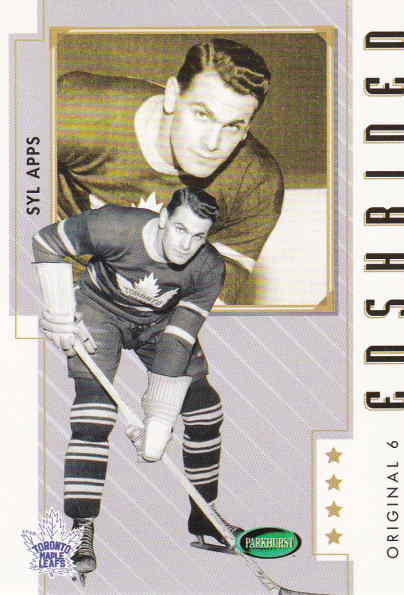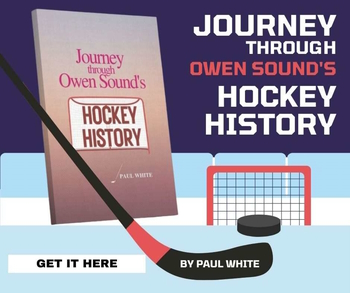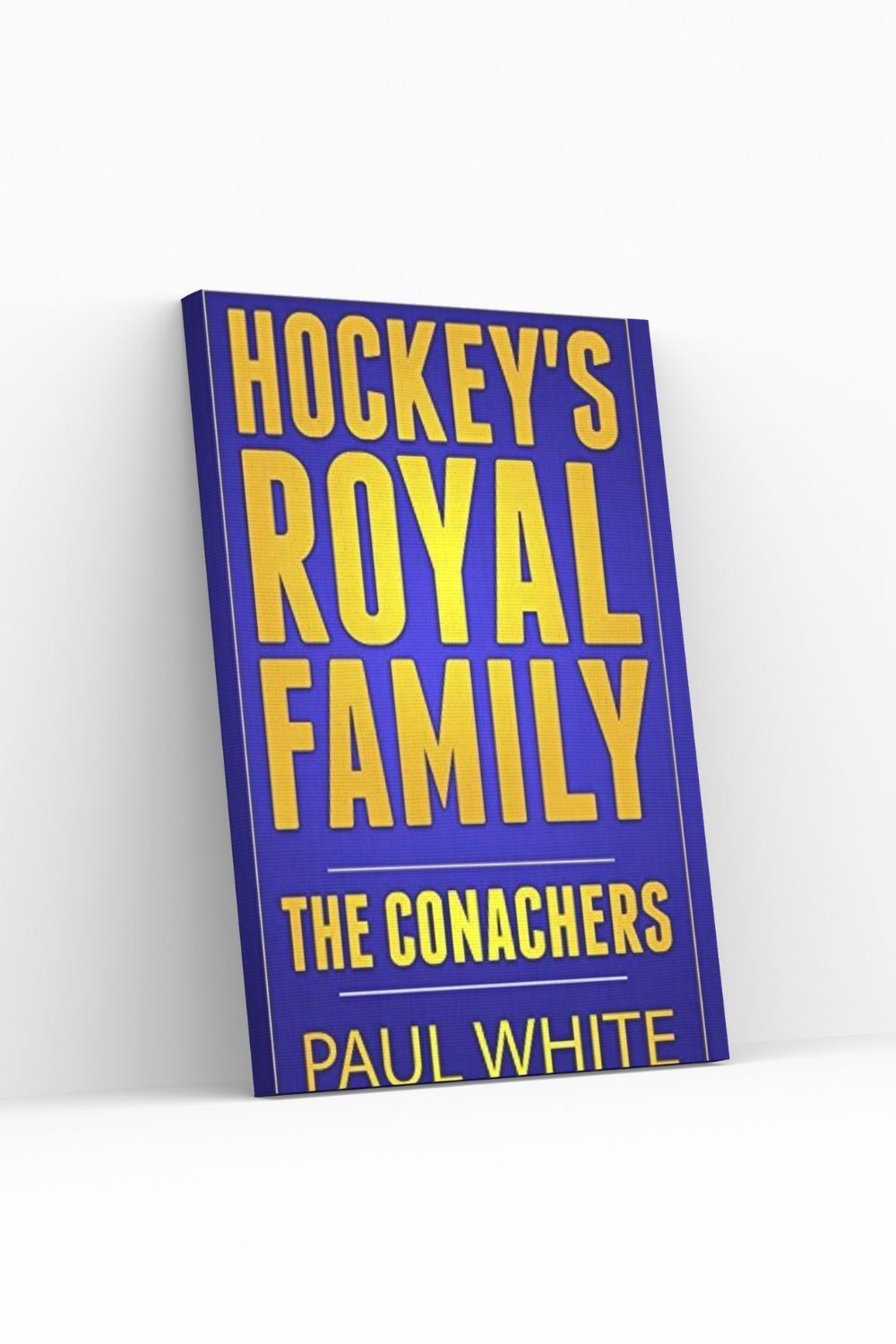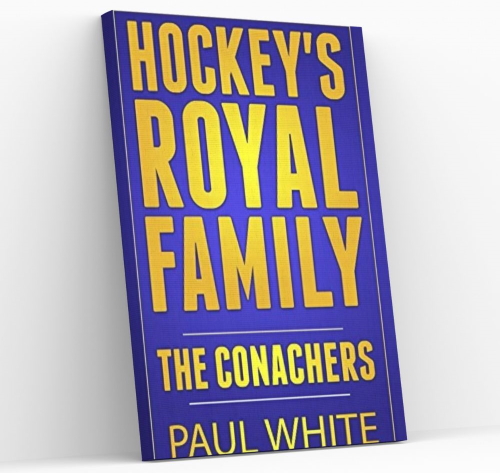Syl Apps:
A Maple Leafs Icon
Syl Apps: A Maple Leafs icon whose smooth skating Hockey Hall of Fame talents made him one of the greatest All-Time hockey players in the history of the NHL. Ironically, before he became a Maple Leaf one NHL general manager decided not to sign him to a contract solely because Apps had aspirations of becoming a minister!
Art Ross, coach and general manager of the Boston Bruins, originally scouted Apps. But Toronto Maples Leafs’ owner Conn Smythe, in his biography, Conn Smythe: If You Can’t Beat ‘Em In The Alley, co-authored by Scott Young, recalled Ross saying “…he was dammed if he wanted a minister on his team anyway.” To further the irony, Smythe made the decision to hire Apps while watching him play football. He had to wait until hockey season to see Apps play hockey for the first time.
|
Sylvanus (“Syl”) Apps, alias “Slippery Sly” or “The Commish,” was born in Paris, Ontario, on January 18, 1915. He played his entire professional career with the Toronto Maple Leafs. Like most young Canadian boys, he may have spent his childhood dreaming of a career in the NHL. But Apps was more than just a great hockey player. |
 Syl Apps Toronto Maple Leafs - Paul White Sports Memorabilia Collection Syl Apps Toronto Maple Leafs - Paul White Sports Memorabilia Collection |
He was an all-around athlete, playing not only hockey, but also football while he attended McMaster University.
Syl Apps: A World Class Pole Vaulter
But, long before Syl Apps became a favorite of Leaf fans across Canada, he had gained international recognition in a field completely disconnected with either of his two main sports. Syl was a world class pole vaulter! In 1934, he captured the Canadian and British Empire pole vaulting championship. Before turning to professional hockey, the two-time Canadian champ represented his country at the 1936 Berlin Olympics, placing sixth among the world’s elite vaulters.
Apps joined the Maple Leafs in 1936 and he wasted very little time establishing himself. He received the Calder Trophy as the league’s outstanding rookie becoming the first Maple Leaf to win this award.
Apps started his first season with the Leafs at centre on a line between Charlie Conacher and Harvey “Busher” Jackson. Conn Smythe hoped to fill the spot on what had formerly been known as the “Kid Line”, which had been created by former centreman Joe Primeau’s retirement. But that experiment didn’t succeed.
The Leafs then tried Apps with another rookie, Gord Drillon, and the two youngsters immediately clicked. But they needed a complimenting third linemate. Smythe added Bob Davidson, who had come up through the Leafs’ hockey system, and immediately the trio became a highly effective unit, both offensively and defensively.
Apps’ notched 16 goals and accumulated a league-leading 29 assists in his first season. His second season wearing the blue and white jersey was even better than his first. Once again led the league in assists with 29, but he netted 5 more goals than in the previous season, for a total of 21.
Syl was a hard working but clean player, who seldom took penalties. In fact, Apps did not receive a single penalty during the entire 1941-42 season. He seldom took bad penalties. In his ten-year NHL career, he amassed a grand total of only 56 penalty minutes, which is less than three two-minute minor penalties a year.
But that 1942 season stands out in the long and storied history of the Toronto Maple Leafs for another reason. The Leafs captured the Stanley Cup in the most dramatic fashion ever witnessed in NHL history to that date.
The Detroit Red Wings opened the finals that season with three straight, decisive victories. It looked as if the Stanley Cup would be going to Motor City. The fourth and what seemed certain to be the final game was to be held in Detroit. With their backs to the wall the Leafs were desperate for a victory. In a 1975 interview with writer Jack Batten, Apps recalled the atmosphere in the Leafs’ dressing room before that fourth game. “The only thing on our minds was, 'We can’t go back to Toronto if we lose this game, too.’ We were thinking we couldn’t lose four straight and face the people back home.”
The Leafs battled back to win the next three games and force a seventh game.
The seventh game took the adversaries back to Toronto, where the whole city was hyped with Stanley Cup fever. A record crowd of 16,218 jammed into Maple Leaf Gardens to cheer on their heroes. For two periods it looked like Red Wings’ goalie Johnny Mowers would spoil the Leafs’ Cinderella comeback. But in the third period the Leafs roared back, scoring three unanswered goals. And with that, the 1942 Toronto Maple Leafs accomplished a feat that has never been duplicated in the history of the NHL. They became, and they remain, the only team to ever lose the first three games of a Stanley Cup final series and then win the final four games to capture the coveted trophy.
This dramatic Stanley Cup victory was engineered, in large part, by their captain. Apps led all scorers in post-season play that year. Although he scored only 5 goals, he amassed a league-best 9 assists and captured the play-off scoring race with 14 points. These numbers do not stand out compared to today’s play-off scoring feats, but in 1942 there were only two play-off rounds compared to the four rounds played today.
Apps was considered the consummate gentleman by all who knew him, never swearing or drinking. When he became extremely agitated over a situation, he would express his irritation or anger with such unseemly expressions as, “By hum!” But this restrained attitude did not mean that Apps allowed others to take advantage of his quiet nature. Early in his career, Boston defenceman "Flash" Hollett high-sticked Apps, knocking out two of his teeth. Realizing that he had to make a statement, Apps promptly dropped his gloves and proceeded to give the surprised Hollett a severe beating. After that outburst, players around the league received the message and everyone steered clear of the Leafs’ centreman.
Another example of App’s honour and sense of fair play occurred during the 1942-43 season. Apps broke his leg during a game. A week after the incident he hobbled into Smythe’s office with a surprise for the Leaf’s owner. According to Smythe, Apps handed him a cheque for one thousand dollars, saying that he felt he shouldn’t be paid until he could once again contribute to the team. Smythe declined his offer. Interestingly, that one-thousand-dollar cheque represented one-sixth of Apps’ annual salary.
Apps missed the 1943-44 and 1944-45 NHL seasons due to serving in the Canadian Armed Forces.
Prior to joining the Canadian war effort, Syl had achieved much success in the NHL. He captured the Lady Byng Trophy and the Stanley Cup in 1941-42. He was named the League’s All-Star Centre twice and to the Second All Star Team three times.
He returned from the war in time to play for the Leafs in the 1945-46 season. During the next three years he notched 24, 25 and 26 goals, leading Toronto to two more Stanley Cup victories.
Syl Apps retired at the end of 1947-48 season with 201 goals, an average of 20 goals per season. It should be remembered that during the 1940s, a 20-goal season was the mark of truly superior goal scorer and hockey player. However, Apps didn’t reach the 200-goal scoring plateau without a touch of drama. Entering the last game of the season he had tallied 198 goals, two goals short of the impressive 200 mark. In that last regular season game of his career, Apps pulled off a hat trick to ensure his place in history. It was a truly remarkable feat. To cement his reputation as a winner, Apps led the Leafs to a Stanley Cup victory in his last season.
Apps was only 33 years old when he retired. According to teammate Sid Smith, “…he could have played another five or six years.”
Syl Apps has been recognized not only as one of the great hockey centers of all time, but also for his other athletic endeavors. He is an honoured member of the Hockey Hall of Fame, the Canadian Sports Hall of Fame, and the Canadian Amateur Athletics Hall of Fame. On October 3, 1993, the Toronto Maple Leafs hoisted a banner bearing the image of Syl Apps and his #10 jersey to the rafters of Maple Leaf Gardens.
|
This article is a shortened version from a story that I wrote about Syl Apps in a book entitled Great Centremen: Stars of Hockey's Golden Age, which was part of the Amazing Stores series by Altitude Publishing |
Great Centremen: Stars of Hockey's Golden Age
|
More Great Hockey History Stories
Syl Apps: A Maple Leafs Icon whose smooth skating HHoF talents make him one of the greatest All-Time hockey players in the history of the NHL. Ironically, before he became a Maple Leaf one NHL general manager decided not to sign him to a contract solely because Apps had aspirations of becoming a minister!
Jean Beliveau, an outstanding hockey player, baseball player, a nice guy who in Quebec City was known as the "Ice Cream Man".
Tommy Burlington: the Greatest North American Never to Play in the NHL captured scoring titles in every league that he played, bringing comparisons to NHL greats.
Alex Faulkner: NHL Pioneer only played one game as a Toronto Maple Leaf, but to hockey fans in Newfoundland it was an important hockey game!
Forbes Kennedy suited up for 13 regular season games and one playoff game as a Toronto Maple Leaf. But a lot can happen in 14 hockey games!
Ted "Teeder" Kennedy a Leafs Legend was almost a member of the Montreal Canadiens but a homesick 16 year-old changed that by leaving Canadiens training camp for home.
Hockey history: Florida details the one-year life of the Tropical Hockey League that entertained fans in the south Florida region in the late 1930s.
Larry Jeffrey started his career as a Red Wing, won a Stanley Cup with Toronto, had a short stint as a Ranger and then retired to the beach in Goderich, Ontario!
Rocket Richard, Montreal Canadiens superstar sniper was a goal-scoring nightmare for goalies especially for one NHL goaltender in particular.
Paul Henderson: A Canadian Hockey Hero, "I scored six really good goals and the garbage goal is the one that everyone remembers.”
W.O.A.A. - Western Ontario Athletic Association was the idea of one man that grew to successfully promote sports in western Ontario.
Hockey history is full of surprises, amazing stories and athletes who never cease to surprise. It is more than just stories about the NHL, it is tales from the minor leagues, the bush leagues, and much more. And, it is not just a Canadian story.






